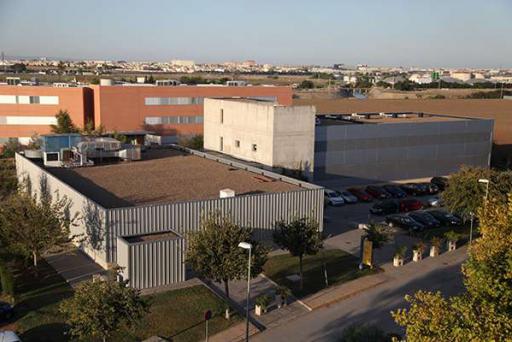Artworks
Andalusian Centre For Advanced Marine Studies
Description
The Puerto Real Campus of the University of Cádiz is located on the drained marshes of the River Guadalete bordering the La Bahía Nature Park. This provides the optimal location for a university site, and the Faculty of Sciences was founded there in 1979.
The Andalusian Centre for Advanced Marine Studies (CASEM) responded to a need for a centre specialising in new technical and scientific developments in the field of Marine Studies, which are synergised in the Centre for Nautical Sciences, Marine Technical Engineering and Marine and Environmental Sciences.
To meet this need, a large east–west-facing building was conceived, which is now an iconic landmark on the Puerto Real campus. This is communicative architecture, whose habitat enhances its content. The design of the ground-plan imitates the form of a three-blade propeller, in a nod to the educational provision delivered on the site. Each the wings of the building is therefore known as Blade A, B and C, respectively. The three elongated rectangular wings are covered with a barrel vault roof light and all meet at one end in a circular area, which acts as a concourse and distribution floor for the building. Twelve pillars support a glass dome topped by small cupola.
The building is divided into four floors (basement, ground, first and second floors), each performing a different function. They share a similar layout and are connected to each other by means of a central staircase that surrounds the circular concourse and a second one leading to the basement. Each wing features a split-level glass mezzanine – this being open, in the case of Blade C – linked by open staircases positioned longitudinally at the centre of the concourse area with access to each of the floors, and two additional staircases that assist circulation around the building. One is located at the side, except in the case of Blade C; and the other at the far ends of the floors. Both sides contain long corridors providing circulation between the various rooms, laboratories, workshops, teaching spaces and offices.
The main staircase reaches as far as the very top of the building, up to the dome. This highlights a third floor within the tholobate, set up as study zone, which provides excellent panoramic views. This latter feature has a staircase leading to the dome, which serves as a planetarium and Museum of Nautical and Maritime Navigation. A stair ladder leads to the roof lantern, which is also accessible.
Regarding the interior of the building, worthy of particular note are the two eight-pointed stars that dominate the hall, one on the marble floor and the other in the form of a textured plaster relief on the ceiling. The star is a symbol of Andalusian identity that can be traced back to Tartessian mythology and its sun worship.
Volumetrically, the exterior is straightforward and stands out in its natural setting. Three ivory-coloured concave façades – comprising two porticoed sections set on four pillars – form the structure. This structure, which is topped off by the dome and its glass cupola, comprises simple façades of curtain walling and the main entrance. A row of steps leading up to the entrance features the inscription “University of Cádiz Faculty of Nautical, Marine, and Environmental Sciences and School of Technical Marine Engineering”.
Details
- Title: Andalusian Centre For Advanced Marine Studies
- Category: Building
- University: University of Cádiz
- Authors: Anonymous Author


 EN
EN  ES
ES 




